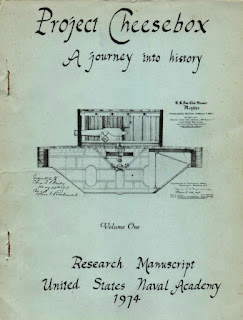 |
| John Broadwater witnesses raising of Monitor turret in 2002 |
In 1972, as a young scuba diver with a passion for diving on shipwrecks, I joined Underwater Archaeological Associates, a group of avocational archaeologists in North Carolina. We read a book called “Always Another Adventure,” by famous underwater explorer Robert Marx.
We were excited to read that he claimed to have discovered (in 1955) the famous USS Monitor lying in 45 feet of water less than two miles from Cape Hatteras lighthouse. He wrote that he was never able to confirm the discovery because shifting sands had covered the wreck.
We decided to (locate) the Monitor and become famous and respected among ocean explorers. After much networking and begging, we were able to borrow a top-of-the-line Klein Associates side-scanning sonar, an instrument that could locate object protruding from the ocean bottom. We also obtained a high-quality magnetometer, capable of detecting very small amounts of iron or steel. Our members contributed their own boats and dive gear.
Before the year was out, we discovered that “Monitor fever” had spread to other adventurers. In all, at least seven different groups conducted searches for the Monitor in what I began calling “the Year of the Monitor”.
The team I led consisted of Underwater Archaeological Associates, Marine Archaeological Research Services (a company I co-founded), and, eventually, the USS Monitor Foundation of Washington, DC. One day, another search team dramatically made itself known: a U.S. Navy P-3 Orion flew low over our search boat at Hatteras.
In August, a former Naval Academy graduate announced that he was going to look for the Monitor in deep water south of Diamond Shoals where the U.S. Navy had detected a shipwreck in 1950 using a device called an Underwater Object Locator. The Monitor had not been so popular since its battle with CSS Virginia on March 9, 1862.
However, we found nothing at all near the Marx location. No shipwreck or other debris of any kind. In August 1973, I learned from Gordon Watts that the Monitor had been discovered 16 miles southeast by the R/V Eastward, from Duke University Marine Laboratory. We had failed in our quest because we trusted Marx’s story. (Marx died in 2019).
'Discovering' Monitor in Gordon Watts’s living room
One of my most prized recollections of the Monitor discovery took place during a late December (1973) visit to Gordon Watts’s home. I had been working part time in Gordon’s lab and we had become good friends. He invited me to his house to show me his latest interpretation of the many video views of the wreckage he believed was the Monitor. Because of the poor quality of the video and the limited coverage of the site, most people were skeptical of the identification.
 |
| Broadwater was on Alcoa Seaprobe on Monitor trip in April 1974 |
Then Gordon said, “OK, now look again, but this time assume the Monitor is lying upside down, lying on top of its gun turret.” He showed me a hypothetical sketch he’d made of this configuration, viewed from the stern.
My mental image of the site almost instantly became clear: Monitor had rolled over, her turret had fallen to the bottom, and her hull landed atop the displaced turret. It was obvious that Gordon has solved the mystery! I was the first person Gordon had shared his theory with so, in a sense, I’ve always felt like I played a small role in the “discovery” of the Monitor.
There were still plenty of doubters, however, and it wasn’t until a photomosaic (above) of the wreck was produced aboard the R/V Alcoa Seaprobe in April of the following year that the question was put to rest. I was honored to have helped develop that mosaic.
PICKET COVERAGE OF USS MONITOR
-- Cathryn Newton: At 16, she was the youngest crew member. She says the find was a group effort.
-- John Harris: He became a hang glider pilot and founded Kitty Hawk kites. But first, he ran the 1973 expedition's underwater camera system.
-- Gordon Watts: Young archaeologist confirmed location of shipwreck.
-- Go deep for 50th anniversary of USS Monitor discovery: Printable 3D artifacts, webinar and a 360-degree video of ironclad's resting place
-- USS Monitor: Navy recognizes Virginia museum for cleaning of ironclad's two Dahlgren guns, which are still being conserved
-- The USS Monitor overcame doubters. Its crew trusted the ironclad, even during the terrible storm that sank the famous ironclad.
-- What do USS Monitor, Jimmy Fallon have in common? Saugerties, NY. This town morphed from industrial 'Inferno' to a cool tourist spot
























